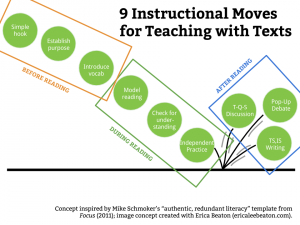Ashley Pacholewski sent me an email this week. Ashley is a teacher at Brunswick High School in Ohio, and she had a great question: “What discussion strategies do you use at the end of the week when using Kelly Gallagher's Article of the Week assignment?” Since I was already in “filming lessons mode” for the Teaching with Articles Workshop, I immediately thought, Sweet — I'll film an example and share it in my next article.
First of all, do students need to discuss everything they read?

As I wrote recently, there are nine basic moves that I draw from when teaching any text to my students (see Figure 1). With anything I ask my students to read, I want them doing some kind of writing, discussing, and/or arguing. The “and/or” isn't thoughtless; what I have my students do after reading derives largely from why I've asked them to do the reading in the first place. Our purposes dictate our means.
So, no, students don't need to discuss everything they read — but just remember that you'll possibly never give your students enough speaking instruction and speaking practice in a year. Around the USA, our kids are simply behind where they could be. That's not to demoralize you or place guilt; it's to stoke your fire.
Fire up, baby! Let's get our kids speaking!
Secondly, efficiency is king with discussions
I'm pretty convinced that, in any given lesson, the shortest path to an objective is the best one. The less time we waste, the more time our kids have to increase their volume of reading, writing, or speaking.
Every great teacher I've ever watched has been a master of instructional efficiency. They spend just the time needed on every part of the lesson, and not a moment more. They don't compulsively barf words at students; they avoid getting side-tracked. They are who I hope to be one day.
So, to go back to Ashley's question, one method we can use to help students create, say, solid Friday discussions of the article of the week assignment is the pop-up debate structure. Keep in mind that this structure is really just a method for managing whole-class speaking situations — I've written before about applying it to things like end-of-the-year toasts.
But the limitation with pop-up debates is that it's not as efficient as I would need it to be if I wanted students discussing every article of the week every Friday. A full pop-up debate in which every student speaks at least one time takes at least 20 minutes in a class of 35 students, and often 5 to 10 minutes more. Ideally, the AoW takes no more than 15 minutes of class time on a Monday and 15 minutes on a Friday (for me with 60-minute class periods, this would be 10% of instructional time, which would be the high end of what I'm comfortable with).
This is why I don't always use PUDs. They are efficient, but there's a more efficient way to get every student speaking in a lesson: small group discussions. To make these as good as they can be, a strategy I try is the pair- or quad-based “Conversation Challenge.” I'll share that in my next article. (I apologize for being coy — I simply don't have the Internet bandwidth right now to upload the classroom video I want to share.)[hr]
Thank you to Ashley Pacholewski for her question, to Kelly Gallagher for sharing his article of the week assignment with the world in Readicide, to Mike Schmoker for his clarifying work (in Focus) that led me to nine moves, and to Erik Palmer, who has faithfully beaten the “Don't neglect speaking instruction” drum for much longer than I've been writing (he first beat that drum in my own head through his Well-Spoken).
Leave a Reply